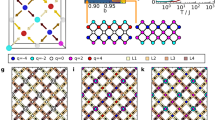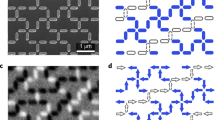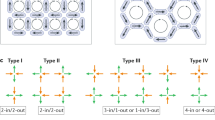Abstract
Artificial spin ice1 is a class of lithographically created arrays of interacting ferromagnetic nanometre-scale islands. It was introduced to investigate many-body phenomena related to frustration and disorder in a material that could be tailored to precise specifications and imaged directly. Because of the large magnetic energy scales of these nanoscale islands, it has so far been impossible to thermally anneal artificial spin ice into desired thermodynamic ensembles; nearly all studies of artificial spin ice have either treated it as a granular material activated by alternating fields2 or focused on the as-grown state of the arrays3. This limitation has prevented experimental investigation of novel phases that can emerge from the nominal ground states of frustrated lattices. For example, artificial kagome spin ice, in which the islands are arranged on the edges of a hexagonal net, is predicted to support states with monopolar charge order at entropies below that of the previously observed pseudo-ice manifold4. Here we demonstrate a method for thermalizing artificial spin ices with square and kagome lattices by heating above the Curie temperature of the constituent material. In this manner, artificial square spin ice achieves unprecedented thermal ordering of the moments. In artificial kagome spin ice, we observe incipient crystallization of the magnetic charges embedded in pseudo-ice, with crystallites of magnetic charges whose size can be controlled by tuning the lattice constant. We find excellent agreement between experimental data and Monte Carlo simulations of emergent charge–charge interactions.
This is a preview of subscription content, access via your institution
Access options
Subscribe to this journal
Receive 51 print issues and online access
$199.00 per year
only $3.90 per issue
Buy this article
- Purchase on Springer Link
- Instant access to full article PDF
Prices may be subject to local taxes which are calculated during checkout





Similar content being viewed by others
References
Wang, R. F. et al. Artificial ‘spin ice’ in a geometrically frustrated lattice of nanoscale ferromagnetic islands. Nature 439, 303–306 (2006)
Ke, X. et al. Energy minimization and AC demagnetization in a nanomagnet array. Phys. Rev. Lett. 101, 037205 (2008)
Morgan, J. P., Stein, A., Langridge, S. & Marrows, C. H. Thermal ground-state ordering and elementary excitations in artificial magnetic square ice. Nature Phys. 7, 75–79 (2011)
Qi, Y., Brintlinger, T. & Cumings, J. Direct observation of the ice rule in an artificial kagome spin ice. Phys. Rev. B 77, 094418 (2008)
Castelnovo, C., Moessner, R. & Sondhi, S. L. Magnetic monopoles in spin ice. Nature 451, 42–45 (2008)
Fennell, T. et al. Magnetic Coulomb phase in the spin ice Ho2Ti2O7 . Science 326, 415–417 (2009)
Morris, D. J. et al. Dirac strings and magnetic monopoles in the spin ice Dy2Ti2O7 . Science 326, 411–414 (2009)
Ryzhkin, I. A. Magnetic relaxation in rare-earth oxide pyrochlores. J. Exp. Theor. Phys. 101, 481–486 (2005)
Möller, G. & Moessner, R. Magnetic multipole analysis of kagome and artificial spin-ice dipolar arrays. Phys. Rev. B 80, 140409(R) (2009)
Chern, G.-W., Mellado, P. & Tchernyshyov, O. Two-stage ordering of spins in dipolar spin ice on the kagome lattice. Phys. Rev. Lett. 106, 207202 (2011)
Baxter, R. J. Exactly Solved Models in Statistical Mechanics (Academic, 1982)
Pollard, S. D., Volkov, V. & Zhu, Y. Propagation of magnetic charge monopoles and Dirac flux strings in an artificial spin-ice lattice. Phys. Rev. B 85, 180402(R) (2012)
Ladak, S., Read, D. E., Perkins, G. K., Cohen, L. F. & Branford, W. R. Direct observation of magnetic monopole defects in an artificial spin-ice system. Nature Phys. 6, 359–363 (2010)
Mengotti, E. et al. Real-space observation of emergent magnetic monopoles and associated Dirac strings in artificial kagome spin ice. Nature Phys. 7, 68–74 (2011)
Nisoli, C. et al. Effective temperature in an interacting vertex system: theory and experiment on artificial spin ice. Phys. Rev. Lett. 105, 047205 (2010)
Remhof, A. et al. Magnetostatic interactions on a square lattice. Phys. Rev. B 77, 134409 (2008)
Möller, G. & Moessner, R. Artificial square ice and related dipolar nanoarrays. Phys. Rev. Lett. 96, 237202 (2006)
Branford, W. R., Ladak, S., Read, D. E., Zeissler, K. & Cohen, L. F. Emerging chirality in artificial spin ice. Science 335, 1597–1600 (2012)
Morgan, J. et al. Real and effective thermal equilibrium in artificial square spin ices. Phys. Rev. B 87, 024405 (2013)
Kapaklis, V. et al. Melting artificial spin ice. New J. Phys. 14, 035009 (2012)
Budrikis, Z. et al. Domain dynamics and fluctuations in artificial square ice at finite temperatures. New J. Phys. 14, 035014 (2012)
Silva, R. C. et al. Thermodynamics of elementary excitations in artificial magnetic square ice. New J. Phys. 14, 015008 (2012)
John Greaves, S. & Muraoka, H. Formation of thermally induced ground states in two-dimensional square spin ices. J. Appl. Phys. 112, 043909 (2012)
Newman, M. E. J. & Barkema, G. T. Monte Carlo Methods in Statistical Physics (Clarendon, 1999)
Rougemaille, N. et al. Artificial kagome arrays of nanomagnets: a frozen dipolar spin ice. Phys. Rev. Lett. 106, 057209 (2011)
Lammert, P. E. et al. Direct entropy determination and application to artificial spin ice. Nature Phys. 6, 786–789 (2010)
Morrison, M. J., Nelson, T. R. & Nisoli, C. Unhappy vertices in artificial spin ice: degeneracy from vertex-frustration. New J. Phys. 15, 045009 (2013)
Chern, G.-W., Morrison, M. J. & Nisoli, C. Engineering degeneracy: a critical ground state for artificial spin ice. Preprint at http://arxiv.org/abs/1210.8377 (2012)
Farhan, A. et al. Exploring hyper-cubic energy landscapes in thermally active finite artificial spin-ice systems. Nature Phys. 9, 375–382 (2013)
Porro, J. M. et al. Exploring thermally induced states in square artificial spin-ice arrays. New J. Phys. 15, 055012 (2013)
Acknowledgements
This project was funded by the US Department of Energy, Office of Basic Energy Sciences, Materials Sciences and Engineering Division under grant no. DE-SC0005313. Lithography was performed with the support of the National Nanotechnology Infrastructure Network. The work of C.N. and G.-W.C. was carried out under the auspices of the US Department of Energy at LANL under contract no. DE-AC52-06NA253962. Work at the University of Minnesota was supported by the NSF MRSEC under award DMR-0819885 and EU Marie Curie IOF project no. 299376. Certain theory elements were supported by the NSF MRSEC under award DMR-0820404.
Author information
Authors and Affiliations
Contributions
P.S., C.L. and V.H.C. initiated this study and supervised the experiments, data analysis and simulations. Artificial spin-ice array fabrication, measurement and data analysis was performed by S.Z. and I.G. Thin film deposition and characterization was performed by L.O’B. and M.J.E. The thermal annealing process was refined and performed by L.O’B., M.J.E. and C.L. Simulations, some data analysis and theoretical interpretation were provided by C.N., G.-W.C. and P.E.L. I.G., C.N. and P.S. wrote the paper with input from all the co-authors. S.Z. and I.G. contributed equally to this work.
Corresponding author
Ethics declarations
Competing interests
The authors declare no competing financial interests.
Supplementary information
Supplementary Information
This file contains Supplementary Text and Supplementary Figures 1-11. (PDF 1517 kb)
Rights and permissions
About this article
Cite this article
Zhang, S., Gilbert, I., Nisoli, C. et al. Crystallites of magnetic charges in artificial spin ice. Nature 500, 553–557 (2013). https://doi.org/10.1038/nature12399
Received:
Accepted:
Published:
Issue Date:
DOI: https://doi.org/10.1038/nature12399
This article is cited by
-
Geometrical control of topological charge transfer in Shakti-Cairo colloidal ice
Communications Physics (2023)
-
Exploring the phase diagram of 3D artificial spin-ice
Communications Physics (2023)
-
Distinguishing artificial spin ice states using magnetoresistance effect for neuromorphic computing
Nature Communications (2023)
-
Kagome qubit ice
Nature Communications (2023)
-
Real-space imaging of phase transitions in bridged artificial kagome spin ice
Nature Physics (2022)
Comments
By submitting a comment you agree to abide by our Terms and Community Guidelines. If you find something abusive or that does not comply with our terms or guidelines please flag it as inappropriate.



